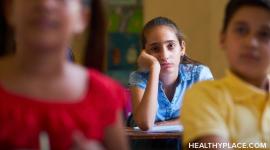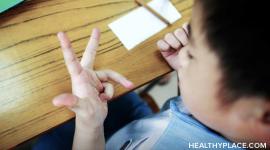How Do Students with Learning Disabilities Affect the Classroom?

Students with learning disabilities are guaranteed under the Individuals with Disabilities Education Act (IDEA) to receive an education in the least restrictive environment. Sometimes in severe cases, that’s a special school for children with learning disabilities. Mostly, though, it’s in a public school where they might be in a special education resource room or in a regular education classroom with other kids who don’t have a learning disability. Either classroom setting has advantages and disadvantages for students with learning disabilities and those without one.
When Students with Learning Disabilities Are Mainstreamed
Services of special education for learning disabilities involves choosing where they will spend most of each school day. In some cases, a child needs to be in the special ed resource room full-time. In other cases, some portion of the day is spent in the resource room and the rest is in the general education classroom. In still others, a child spends their entire day in the general education classroom with their peers.
When a child receives education in a general ed classroom, it’s called mainstreaming or inclusion. There are subtle differences, but because the effects of each can be similar, this article will use both terms.
Inclusion is much more than adding a desk for a student with a learning disability and letting them work there, assisted by a classroom aide. Inclusion means that the teacher:
- Works to meet the needs of every student, with or without an IEP, every day
- Provides different instruction and practice for different kids rather than using one curriculum and lesson plan
- Deliver different instruction methods, working with an aide to divide students into groups and instructing the groups differently
- Uses different teaching approaches, using learning stations, activities, one-on-one tutoring more than large-group lecture
- Stock the room with special equipment and learning materials that every student can use.
With inclusion, all children have an equal chance to reach their potential. In this way alone, a student with a learning disability affects the classroom in a positive way. There are other ways these children positively affect the general classroom, too.
Students with Learning Disabilities Can Have Positive Effects on the Classroom
When a student with a learning disability attends a general classroom, many positive effects impact all students, both with and without a learning disability. The focus becomes less on a student’s disability and more on everyone’s learning and interaction. This can be a relief for the student whose learning disability is always front and center.
Other advantages of inclusion include:
- All students learn empathy, understanding, acceptance of differences
- Students learn that everyone has strengths and weaknesses
- Kids begin to look beyond the disability to see the whole person
- Children see and come to appreciate different ways of thinking
- Students shift their thinking away from the “separate because of differences” notion that is an unintended result of full containment in the resource room
- A child with a learning disability sees that they can learn things like their peers, and these peers see that a child with a learning ability is capable of learning
- Through peer tutoring, everyone participating learns and develops new skills from each other
Students with learning disabilities can affect the classroom, both their peers and themselves, positively. Nothing in life is either all good or all bad, of course, so there are some negative ways mainstreaming affects the classroom, too.
Negative Effects of Mainstreaming Students with Learning Disabilities
Placing students with learning disabilities in a general classroom full-time can cause some problems. Note that it’s the situation that can be problematic, not students themselves.
Some cons of mainstreaming include:
- Behavior problems related to the learning disability can be disruptive
- In response to modifications, accommodations, and specific discipline approaches, students in the class might be resentful, believing that their peer with the learning disability has it easy
- The crowded, fast-paced, “chaotic” environment might overwhelm a child with a learning disability
- Kids with disabilities might feel in the spotlight and intimidated
- It’s difficult for the teacher to give special, individualized instruction to one child while still instructing and giving feedback to the other students—so no one receives the learning attention they need
Perhaps the best effect of students with learning disabilities in the general education classroom is the fact that there are both pros and cons. Every student learns that nothing and no one is perfect but that everyone has strengths and every situation has positives. As a result, students with and without learning disabilities learn how to handle challenges, disruptions, and frustrations. They learn how to be good friends and how to accept each other’s imperfections. All kids affect their classroom profoundly.
See Also:
APA Reference
Peterson, T.
(2022, January 17). How Do Students with Learning Disabilities Affect the Classroom?, HealthyPlace. Retrieved
on 2026, January 1 from https://www.healthyplace.com/parenting/learning-disabilities/how-do-students-with-learning-disabilities-affect-the-classroom



